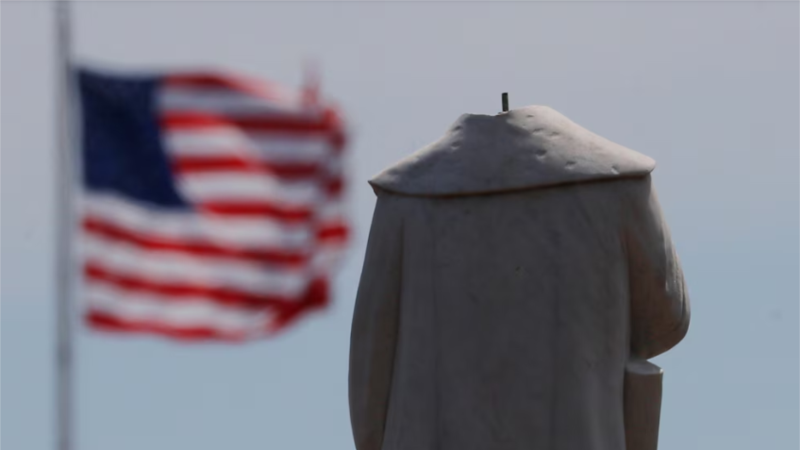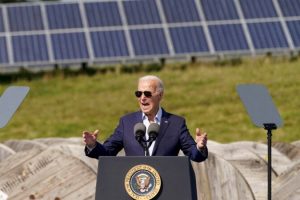In the United States, statues of Christopher Columbus have been decapitated, others have been torn down from their pedestals during protests, and in other cases removed by local authorities. It is estimated that more than 40 monuments erected to the Genoese navigator, who is credited with the discovery of America, have been removed.
Some Latin American cities have not been left behind either: in capitals such as Mexico City and Bogotá, monuments have been removed or changes have been made to contextualize the meanings.
In the United States, Columbus even surpassed the country’s founding fathers in monuments, and today the admiral still ranks third in figures erected on pedestals throughout the country. The United States still has 149 standing monuments, according to the Monument Lab and the Andrew W. Mellon Foundation, with Abraham Lincoln in first position with 193, and George Washington with 171.
When and why did Columbus acquire so much relevance in the US and Latin America?
Historian Héctor Lindo, professor emeritus at Fordham University in New York, explains to the Voice of America that the aggrandizement of Christopher Columbus on the continent occurred in two ways.
In the United States it gains prominence when commemorating the fourth centenary of the so-called “Discovery of America”, which is currently recognized as “The encounter” of pre-Hispanic cultures with the European world, with Columbus and his voyages.
But behind the growing interest of the United States in glorifying the feat of Columbus and elevating him to pedestals, the Italian American diaspora was very involved, trying to achieve notoriety by measuring Italy’s contributions in the New World.
“Those who were most interested were the Italian communities; They identified Christopher Columbus as Italian at a time when that community was marginalized and they needed to show the population of the United States that Italy had contributed a lot,” explains Lindo.
In Latin America, the boost to the figure of Columbus came later, due to an event that was traumatic for the Spanish kingdom, which was already in decline, when it lost the war with the United States in 1898, in which Cuba, the Philippine Islands, Puerto Rico and other territories were left outside its domain.
According to Lindo, Spain began at the beginning of the 20th century to promote associations in the Latin American region – which it saw as a sphere of influence – due to its identification with Hispanicity, which would later lead to recognizing October 12 as Columbus Day.
“Giving relevance to Spain’s relationship with Latin American countries was to counteract the Spanish decline after the Spanish-American War, which was a tremendous trauma and a little to recover its international presence in Latin America,” explains the historian.
The plan had a lot of echo in Latin American countries, which viewed the nascent northern power with fear “because of Anglo-Saxon aggressiveness” after the war in Cuba. Later, with the US intervention in Panama, the occupation of Haiti, and the attempts to dominate Nicaragua, “a movement began to identify with Hispanism and the role of Christianization that Spain had played.”
What led to the reflection of the date?
Social movements for the recognition of minorities and civil rights grew throughout the 20th century, having a turning point in the 1960s, which has led to broader discussions about groups that were marginalized as effects of colonization. that followed the voyages of Columbus.
Among these, the past of slavery of the African American community in the United States and the dispossession of indigenous peoples in Latin America stand out, even when in some countries in the region the populations constitute, to this day, the majority in cases such as Guatemala, Peru, Bolivia, among others. some examples.
This has led historians such as David M. Perry to consider the question of reevaluating the celebration of the date, which in the United States was established in 1898, although it was not until 1937 that it was added to the holidays at the federal level.
Perry published in a specialized article that, although the “undeniable historical impact” of Columbus’s feat with his arrival in America is highlighted, that fact “caused the great era of exploitation in the Atlantic, trade and colonization by Europeans.” ”, with the slave trade as one of the greatest cruelties in the eyes of the present.
It is not surprising that during the movement’s protests, Black Lives Matter(Black Lives Matter), in 2020, after the death of George Floydat the hands of white police officers, the protesters charged their fury with monuments such as those of Christopher Columbus, without paying attention to the historical or artistic value of the pieces.
One of those killed in these protests was the sculpture of Columbus in the city of Baltimore, near Washington, considered the first erected to the Genoese navigator in the world. It dated from 1792.
Is it a solution to change the name of the celebration?
Changing the name of the celebration has been an initiative in the US for which proposals have been recorded since the 1970s, in which it has been considered changing the national holiday for one that represents the Native American peoples.
In 14 states and about 130 cities, including the District of Columbia, the US capital, Columbus Day is celebrated alongside another celebration or fully substituted.
Upon his arrival at the White House in 2021, President Joe Biden joined the clamor for a change in the holiday and decreed that the celebration also recognize Indigenous Peoples’ Day.
Biden then highlighted the undeniable “painful history of mistakes and atrocities that many European explorers inflicted on tribal nations and indigenous communities.”
Does removing monuments solve the problem?
The Salvadoran historian Carlos Cañas Dinarte, based in Spain, told the VOA that the demolition of monuments is “an open dispute over history and memory,” but that it does not lead to solutions and pushes more toward “a manipulation of sensibilities.”
In his opinion, such actions “do not restore rights to the native peoples of the continent, and replacing the destroyed monuments with those of renowned chiefs also exalts empires, kingdoms and lordships that had subjugated others around them, as occurred among the Mayans, Aztecs, and Quechua,” he points out.
Cañas adds that simple elimination leads to seeking replacements, so the work of the media and academia is to “spread messages with content so that each monument is valued in its true essence” so that “the public commemorative landscape is the property of everyone and must reflect diverse sociocultural interests.
A point that historian Héctor Lindo shares is that each monument must be put in context, due to the artistic and historical value it can represent, and from there explain the moments in which they have been created, as part of the urban landscape of American cities. and Latin Americans.
Connect with the Voice of America! Subscribe to our channels YouTube, WhatsApp and to the newsletter. Turn on notifications and follow us on Facebook, x and instagram.
















Add Comment